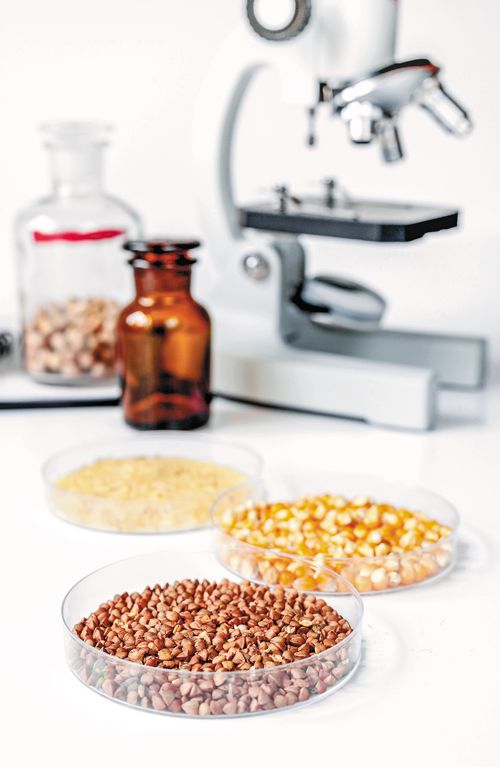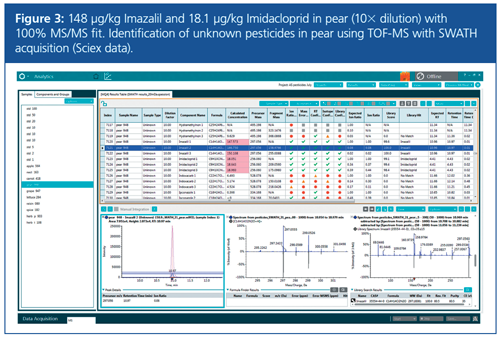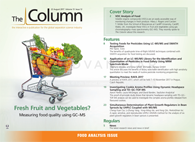Testing Foods for Pesticides Using LC–MS/MS and SWATH Acquisition
Food testing laboratories worldwide are responsible for checking the presence of regulated pesticide residues on food products because these chemicals can be harmful to health and the environment. These laboratories have traditionally relied on gas chromatography coupled with mass spectrometry (GC–MS) for rapid and reliable pesticide detection in large sample numbers. However, changing regulations and increasingly diverse pesticides are driving the need for alternative liquid chromatography tandem mass spectrometry (LC–MS/MS)- based methods for comprehensive screening.
Photo Credit: 279photo Studio/Shutterstock.com

Phil Taylor, Sciex, Framingham, USA
Food testing laboratories worldwide are responsible for checking the presence of regulated pesticide residues on food products because these chemicals can be harmful to health and the environment. These laboratories have traditionally relied on gas chromatography coupled with mass spectrometry (GC–MS) for rapid and reliable pesticide detection in large sample numbers. However, changing regulations and increasingly diverse pesticides are driving the need for alternative liquid chromatography tandem mass spectrometry (LC–MS/MS)- based methods for comprehensive screening.
Pesticides are chemicals that are used to kill and control pests that may damage crops, fruit, and vegetables during cultivation, storage, or transport. Crops, fruits, and vegetables are turned into usable foodstuffs, so it is very important that any harmful substances originating from pesticides are removed, or kept at a very low level. Routine testing of crops, fruits, and vegetables is performed in analytical laboratories around the world to ensure that the public is not exposed to harmful levels of chemicals. In the EU, a network of around 200 laboratories is responsible for testing fruit and vegetables across the region. The testing is overseen by the EU Reference Laboratory (EURL) for Fruits and Vegetables, at the University of Almería in Spain.
Legislation
Today, over 1000 pesticides are used worldwide (1), and they are regulated extensively. The active substance in a pesticide must be approved by the European Commission (2) before it can be used in a crop protection product in the EU. The approval may be granted following an intensive evaluation process that considers the effect of the active substance on people’s health, animal health, and the environment. The European Commission specifies maximum residue levels (MRLs) (3), which define the maximum levels of pesticide residue that are legally permitted in or on food or feed, when pesticides are applied in line with Good Agricultural Practice. Using MRLs means that pesticide residues are maintained at a low level, ensuring that food is safe for consumption. For example, pesticide residues in certain types of food are required to be as low as under 10 µg/kg. In the USA, pesticide level control is regulated on a national level by the Environmental Protection Agency (EPA), which works cooperatively with state agencies to issue guidelines for testing of pesticides.
Traditional Methods for Pesticide Testing
Routine food testing laboratories need highly robust, accurate, and sensitive technologies to detect and quantify the large number of pesticides that could be present in a food sample at very low levels. Mass spectrometry combined with gas chromatography (GC–MS) has traditionally been used for its speed, sensitivity, and ability to detect numerous compounds in a single run (4). However, today’s growing list of regulated pesticides as well as the trend towards lower MRLs means that GC–MS is less suitable because of its limited application to volatile molecules, as well as its requirement for larger sample sizes. This method can also have negative impacts on the environment because of the large quantities of solvents and materials needed. As a result, food testing laboratories are increasingly switching to using liquid chromatography with tandem mass spectrometry (LC–MS/MS) and electrospray ionization (ESI). Not only does this method allow more accurate pesticide detection, but it is also easier to perform and faster than GC-based methods.
Pesticide Analysis Using LC–MS/MS
LC–MS/MS allows multiple pesticide residues to be screened simultaneously, including those that are difficult to detect by GC–MS. Tandem mass spectrometry also allows highly accurate identification of pesticide residues through a selection of specific multiple reaction monitoring (MRM) transitions for each compound, resulting in very high sensitivity, selectivity, and reproducibility. However, this approach can involve an extensive pesticide analysis workflow, which can be time-consuming when several hundred pesticides are being analyzed in a single run.
Foods such as fruits and vegetables are typically complex matrices and frequently contain a high number of active pesticide substances that can be difficult to analyze. Often, several thousand molecules are ionized with a full scan, giving rise to very complex chromatograms where interferences might mask low-abundance analytes of interest. This can lead to identification difficulties using conventional approaches because the ion ratio can change as a result of background matrix effects.
Usually, MS is accomplished in a dataâdependent mode, scanning for designated masses and performing tandem mass spectrometry analysis on the most intense peaks. The process must be repeated several times to obtain reliable statistical data. There is also a risk of missing the identification of an important low-level residue. In addition, traditional data-dependent methods will not detect untargeted chemical residues. Although there is strong legislation for the use of pesticides, there will always be the risk of forbidden, or new, pesticides being used on imported crops. As a result, there is an increasing need for food testing laboratories to develop untargeted, data-independent screening methods.
Data-Independent Acquisition With LC–MS/MS
Recently, SWATH acquisition-based methods have been developed for food testing. SWATH is a unique, data-independent acquisition (DIA) technique that allows comprehensive detection and quantitation of virtually every detectable compound in a sample (MS/MSALL). SWATH acquisition is suitable for quadrupole time-ofâflight mass spectrometers such as triple timeâofâflight (TOF) and quadrupole (Q)TOF systems. Combining LC–MS/MS with data-independent SWATH acquisition allows the tandem MS analysis to be performed across small mass windows so that data can be collected on all pesticide residues in the sample in a single run, with fast acquisition speeds and high resolution (5) (see examples in Figures 1–3).



SWATH also provides a permanent, digital archive of the sample, which allows reâinterrogation of that data without the need to repeat the sample separation and analysis on an extraction that may have degraded significantly. This saves time and removes the need for expensive and inconvenient sample storage. The data can also be used for unknown screening, or retrospective quantitative analysis if any previously unknown pesticides become known.
Enhancing Pesticide Detection With SWATH Acquisition
Scientists at the EURL are responsible not only for proficiency testing of the European network of food testing laboratories, but also for developing and validating new pesticide detection methods for use across the network. Professor Amadeo FernándezâAlba and his team at the laboratory have recently developed SWATH acquisition-based methods for detecting pesticides in baby foods. Baby foods are notoriously difficult matrices to work with, and regulation of pesticides in these foods is particularly stringent as specified in the EU Directive 2006/141/EC (6). Using QTOF-MS/MS combined with SWATH acquisition, the team performed data-independent acquisition with variable windows, making it possible to move to 20 mass windows and produce very clean spectra with 10–12 data points and enough data for quantification. The method was very fast, making it ideal for high-throughput applications, and achieved the levels of sensitivity required with highly reproducible data, both in terms of mass accuracy and quantitative measurements.
Conclusions
Pesticides are used on almost all conventionally grown fruits, vegetables, and crops, therefore it is critical that the levels of pesticide residues in food are kept at regulated, low levels to ensure the health of people and livestock. Globally, numerous laboratories test for pesticide residues, and the popularity of quadrupole time-of-flight MS/MS techniques in combination with SWATH acquisition is growing. One of the major advantages of this approach is the ability to record an unlimited number of compounds in full-scan mode. This allows for an automated, rapid, and simple identification of untargeted pesticides, old or new, making food testing for pesticides more accurate and time efficient.
References
- C. Tomlin, The Pesticide Manual – A World Compendium, 13th ed., (British Crop Protection Council [BCPC], Alton, Hampshire, UK, 2003).
- European Commission EU Pesticides Database, https://ec.europa.eu/food/plant/pesticides_en accessed July 2017
- European Commission Maximum Residue Levels, https://ec.europa.eu/food/plant/pesticides/max_residue_levels_en accessed July 2017
- L. Alder, K. Greulich, G. Kempe, and B. Vieth, Mass Spectrom Rev.25(6), 838–65 (2006).
- F. Qin, J. Gibbons, V. Raguvaran, Y. Wang, and M. Deng (2014). “MS/MSALL with SWATH Acquisition for Targeted Quantitation and Unknown Screening of Pesticides”, AB Sciex poster, Concord, Canada.
- European Commission: Food for infants and young children, https://ec.europa.eu/food/safety/labelling_nutrition/special_groups_food/children_en Accessed July 2017.
Phil Taylor is the Global Marketing Manager, Food, Environment, & Forensic, at Sciex, Framingham, USA.
E-mail: Philip.Taylor@sciex.comWebsite:www.sciex.com

New Study Reviews Chromatography Methods for Flavonoid Analysis
April 21st 2025Flavonoids are widely used metabolites that carry out various functions in different industries, such as food and cosmetics. Detecting, separating, and quantifying them in fruit species can be a complicated process.
Analytical Challenges in Measuring Migration from Food Contact Materials
November 2nd 2015Food contact materials contain low molecular weight additives and processing aids which can migrate into foods leading to trace levels of contamination. Food safety is ensured through regulations, comprising compositional controls and migration limits, which present a significant analytical challenge to the food industry to ensure compliance and demonstrate due diligence. Of the various analytical approaches, LC-MS/MS has proved to be an essential tool in monitoring migration of target compounds into foods, and more sophisticated approaches such as LC-high resolution MS (Orbitrap) are being increasingly used for untargeted analysis to monitor non-intentionally added substances. This podcast will provide an overview to this area, illustrated with various applications showing current approaches being employed.

.png&w=3840&q=75)

.png&w=3840&q=75)



.png&w=3840&q=75)



.png&w=3840&q=75)


![IMG_4773[1].jpg IMG_4773[1].jpg](/_next/image?url=https%3A%2F%2Fcdn.sanity.io%2Fimages%2F0vv8moc6%2Fchroma%2F6db719ea80519dad8e948ad595b96c3fa3731826-200x207.jpg%3Ffit%3Dcrop%26auto%3Dformat&w=3840&q=75)







